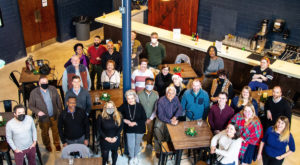With overlapping sustainability requirements from multiple rating systems such as LEED, WELL, and FITWELL, it can seem impossible to find high quality products that have the required certifications and perform reliably. Add into the mix, establishing the design aesthetics for the project, specifying the right product can be an onerous task. With more information and resources available than ever before, the impossible becomes possible by taking a more holistic approach to the material selection process.
The Earlier the Better
Material selection in high-performance projects must be integral to the schematic design and design development phases of the project. The sustainability consultant must meet early with the design team to communicate all requirements as a best practice. As the materials attributes credits of the LEED v4.1 rating systems have expanded, so have the requirements for documenting products with Health Product Declarations (HPDs), Environmental Product Declarations (EPDs), and emissions evaluations certificates. Most major manufacturers today have this information readily available for architects and consultants to use. However, smaller independent manufacturers may require more time to provide this information. For example, the design may call for a specific acoustic ceiling system to create the perfect aesthetic and sound rating, only to find that the product does not have the required emissions evaluation required for Low-Emitting Materials credits. By having the product selection moved earlier within the project phases, headaches can be avoided during construction documentation and construction administration.
Resources and Tools
The best place to start when reviewing materials, is to reach out to your trusted manufacturers. Most will have all required documentation linked to the product on their website, as well as specification tools that will include updated language for inclusion in specifications. Additionally, user friendly healthy materials databases have been developed that will aid in material selection. The International Living Future Institute Declare Database includes a nutrition label for building products and outlines the Red List Chemicals. The SCSglobal Services Certified Green Products Guide refines products by manufacturer, product attribute certification (such as FloorScore, EPD, CARB, etc.) and country.
Less is More
During the design process as the concept is being finalized, it is important to ask whether the material palette can be simplified. One of the greatest impacts on sustainability and carbon footprint that design teams can make is reducing the number of materials produced and used on the project. Additionally, selecting products with a low-embodied carbon footprint or reusing products and furniture will help reduce a projects’ total greenhouse gas emissions. A life cycle assessment (LCA) is an important tool in the material selection process.
Reducing the inherent hazards of a building and its materials with a holistic and integrated approach requires the attention of multiple stakeholders and the application of the above frameworks. This is hard-coded into Epsten Group’s DNA. By using tools to track performance, improve action, and report progress, we stay true to our commitment of fostering an equitable, sustainable, and emotionally and physically healthy environment that cultivates productive, innovative, and creative spaces.
Resources:
“Sources of Greenhouse Gas Emissions.” US Environmental Protection Agency (EPA), April 14, 2022, https://www.epa.gov/ghgemissions/sources-greenhouse-gas-emissions
“Declare- The Nutritional Label for Products.” International Living Future Institute, 2022, https://declare.living-future.org/
“Certified Green Products Guide.” SCSglobal Services, 2022, https://www.scsglobalservices.com/certified-green-products-guide




